Cage Enrichment
In our housing section we also briefly touch upon enrichment. I would like to use this opportunity again to point out that the size of your monkey enclosure is important. The larger their enclosure is, the more your primate will have the opportunity to run/swing around. The way you should enrich their enclosure mainly depends on how they move around. A spider monkey for instance are brachiators so they like to swing with their arms and tail. To accomodate for that behavior, you probably want to run some bars alongside the roof of your cage. Marmosets on the other hand like to spend time exploring so make sure to provide them with plenty of branches that run in different angled positions. Make sure to use your airspace as efficient as possible. When using branches, swings, and ropes, install them at different heights, angles, and make sure to change the setup often to prevent boredom. Most primates also enjoy shelves at installed at different heights. It’s also very important that you provide places where your monkey can hide. Just like us, monkeys do enjoy some privacy from time to time. Lastly, keep safety and washability in mind. Make sure your enrichment items are easy to clean or easy to replace when needed.
Here are a few ideas:
|
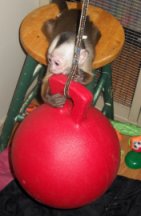 |
How to install enrichment items?
An easy way to install busy boxes is by attaching them with a chain and use a double snap lock to attach it to your wire cage wall. If you want to install them to an inside wall, simply anchor a screw eye into a wall beam and you’ll be able to attach your enrichment items with a double snap lock or a quick link. When installing branches in their enclosure, it is recommended to use screw eyes on both sides so they can be easily be moved and replaced.
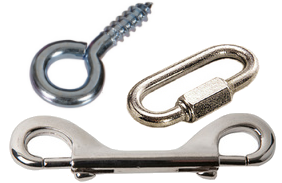
Floor Enrichment
 In the wild primates spent most of their time foraging for food. By using woodchips or straw in your primate enclosure, you’re basically creating the opportunity for natural foraging.
In the wild primates spent most of their time foraging for food. By using woodchips or straw in your primate enclosure, you’re basically creating the opportunity for natural foraging.
Woodchips are often used for inside enclores due to the fact that it is soft to lay on, less cleaning is required, and because it reduces odor since it significantly reduces the growth of bacteria. A 4 to 6 inch layer will remain quite oderless especially in comparising with bare surfaces.
Straw is often used for outside enclosures and although it requires turning after it rains, primates enjoy to lay, throw and roll around in it.
Both straw and woodchips provide excellent foraging opportunity . Dried fruit cubes, cereal (sugarless), popcorn, mealworms, seeds, grains, and nuts are great foraging foods that you can easily scatter on the floor. It will allow your primate to forage for their food.
Animal and Toys for Children
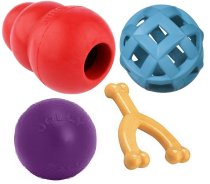 The most suitable animal toys are typically those for large dogs. Obviously the size and type of toys depend on the specie you have. Kong Toys and Nylabone are commonly used for primates since they’re so tough. People often insert treats in Kong Toys (like prima treats from Bio-Serv or peanut butter). You could also drill holes into plastic balls and insert them with sunflower seeds to increase enrichment. Large bird toys are often used for smaller monkeys like marmosets and tamarins.
The most suitable animal toys are typically those for large dogs. Obviously the size and type of toys depend on the specie you have. Kong Toys and Nylabone are commonly used for primates since they’re so tough. People often insert treats in Kong Toys (like prima treats from Bio-Serv or peanut butter). You could also drill holes into plastic balls and insert them with sunflower seeds to increase enrichment. Large bird toys are often used for smaller monkeys like marmosets and tamarins.
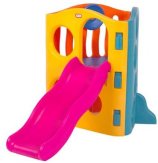 Many primate owners also give their monkey children toys. When using children toys make sure they are very sturdy. Keep in mind that monkeys like to chew and bang their toys around. For smaller monkeys like marmosets, tamarins, and squirrel monkeys, you could attach a music box from fisher price to their cage wall. The bright lights and sounds are certain to entertain your monkey. For larger monkeys attach the music box on the outside of the cage where they monkey hands can still reach the buttons. That will prevent them from destroying these music boxes. Stuffed toys are rather popular amongst primates to cuddle and throw. It is adviced to use stuffed toys made for babies since they’re safer. Outdoor children play furniture are also enjoyed by many primates. One brand in perticular seems to be on top of the list: Little Tikes (shown in the picture: Little Tikes Wave Climber). Throw a blanket over the top which makes the top shelf into a entertaining hiding place.
Many primate owners also give their monkey children toys. When using children toys make sure they are very sturdy. Keep in mind that monkeys like to chew and bang their toys around. For smaller monkeys like marmosets, tamarins, and squirrel monkeys, you could attach a music box from fisher price to their cage wall. The bright lights and sounds are certain to entertain your monkey. For larger monkeys attach the music box on the outside of the cage where they monkey hands can still reach the buttons. That will prevent them from destroying these music boxes. Stuffed toys are rather popular amongst primates to cuddle and throw. It is adviced to use stuffed toys made for babies since they’re safer. Outdoor children play furniture are also enjoyed by many primates. One brand in perticular seems to be on top of the list: Little Tikes (shown in the picture: Little Tikes Wave Climber). Throw a blanket over the top which makes the top shelf into a entertaining hiding place.
Make sure to wash their toys frenquently with water and soap. It’s important to rotate toys for variety and to provide them with new toys every now and then. Make sure to check your toys often to make sure they’re still safe. There are plenty of great toys available at garage sales and thrift shops so shop around often to keep your primates entertained.
Other Enrichment items
When trying to provide enrichment to your monkey, think outside the box. Very often the least expensive toys are those your primate will enjoy the most.
Here are a few ideas:
- Cardboard box: a simple cardboard can keep your monkey busy for several days.
- Magazines: could get messy but your monkey probably won’t stop reading until the entire magazine is destroyed.
- Plastic Storage Drawer: at the side where you open up the drawer, drill a small hole to install a double snap lock. Attach the other side of the snap lock to your cage wire so your monkey can’t flip the container or open the the drawer (lock should block the drawer from opening). Use a hole saw to cut multiple sized holes into the top of the container and fill drawer with food. Once unlocked, the drawer can be easily removed for cleaning.
- Plastic Juice Jug: fill jug with vegatables cut in long strips to make it a bit more difficult for your monkey to remove the items
- Tooth brunch
- Unbreakable metal mirror
- Blankets: most primates seem to enjoy soft blankets. They’ll use it for hiding, cuddling, or to drag it around.
- Horse Hay Bags: simply hang them up in your cage for your monkey to sit in or climb on.
- Coconut Shells
- Paper Sacks
- Mango seeds: dry the seed for 1 to 2 days before giving the seed to your monkey. Mango seeds are nontoxic and can be eaten.
- Corncobs: dried clean corncobs are also excellent chew toys
- Balls
- Dog Pool: perfect for your outdoor enclosure in those hot summer months for certain species like macaques, guenons, but also capuchins.
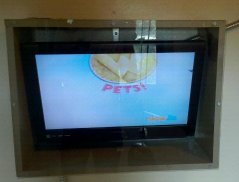 TV: keep the tv outside the monkey enclosure or build a box around the tv as shown in the picture to the right. In the front plexi glass is used to protect the tv. A tv is another way to keep your primate busy and just like with humans, every primate seems to have their favorite channel. For Benji, a capuchin monkey, spongebob seems to be the all time favorite.
TV: keep the tv outside the monkey enclosure or build a box around the tv as shown in the picture to the right. In the front plexi glass is used to protect the tv. A tv is another way to keep your primate busy and just like with humans, every primate seems to have their favorite channel. For Benji, a capuchin monkey, spongebob seems to be the all time favorite.
Send us tips on primate enrichment so we can share them on our site!
Monkey Toys
February 25, 2018 12:52 am
By Mary Lynn Campbell
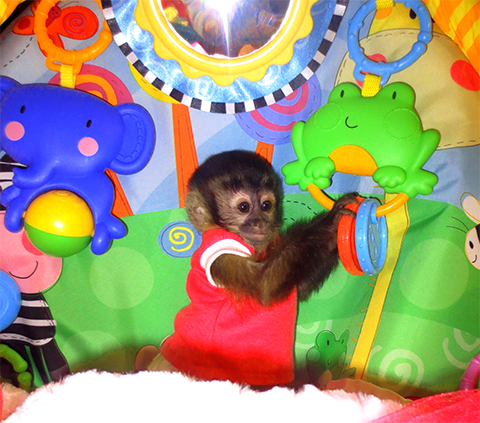
Olivia – 5 Weeks Old
Happy New Year From Primate Care. We are excited to start 2018 with a post about monkey toys. All monkeys love toys from the very beginning of their lives. In my book “Living With Monkeys”, which is for sale on our sister site primatestore.com, I wrote about helping baby monkeys to not bite by offering things for them to chew on instead of your fingers, hands and hair. Yes, even your hair can become one of their favorite play things. Monkeys love to chew on everything.
When Bob and I were raising Silly Willy and he started to put his mouth on us, I knew it was time to offer him something to put his mouth on instead of us. Baby monkeys are not able to hold extremely large toys, so I went through the house and gathered things that I felt would fit into his small hands and then put small dishes full of these things into the rooms of the house that he was taken into.
The things that I chose to put into the dishes were things like: plastic Bic pen tops, medium size springs, medium size washers, large paper clips, medium key rings, plastic rings that are used to hang toys on baby cribs, plastic coke bottle caps, milk bottle caps, and any other small safe things that I could find. Of course, I washed these toys frequently to ensure that they were safe for my little guy.
I have also learned from many other monkey caregivers that some babies come with even more of a “mouthy problem” than Silly Willy came with and that their monkeys chose to put their mouth on everyone’s hands every time their baby monkey was being handle
. I know this must be a challenging behavior as a caregiver is trying to train their baby monkey to not do this. Due to this being such a problem, the little ones will become very hard to deal with when languaging with them using the word ‘NO’ so often.
Posted in enrichment, monkey toys, primate toys, special topics
Foraging for fun and fitness
January 25, 2017 4:56 pm
By Janice Metzger
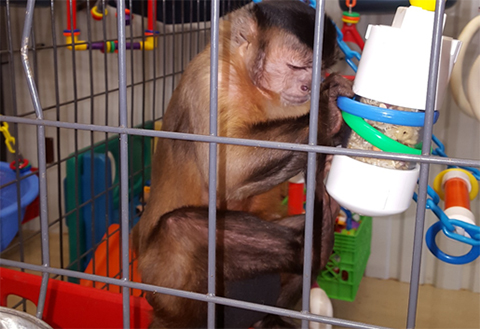
Wild-living monkeys spend the majority of their time searching for food and consuming it. Foraging activities take up the largest part of their day, followed by play and social grooming. Foraging activities provide opportunities for primates in the wild to interact with one another and work together to obtain food. Foraging affords an opportunity for exercise and muscle building, which keeps the wild-living monkey’s caloric intake and energy expenditure ratio in balance.
Working for food, or foraging, is mentally stimulating for our captive-living primates as well. Providing opportunities for our monkeys to search out and forage for food helps to reduce boredom and encourages healthy movement and activity. Anything we can do to make our monkeys’ food more difficult to obtain and consume stimulates higher order thinking skills such as problem-solving and strategizing. Placing foraging devices high in the enclosure or outside it encourages climbing, stretching and reaching.
more...
Posted in enrichment, feeding
Sell at Primate Store
May 25, 2016 4:49 pm

Many of the toys. primate enrichment devices, monkey diaper covers and clothes used by primate owners are handmade. Thanks to social media, the creators of such products have the ability to market their products to a limited community. Unfortunately on social media your audience is very limited and as a buyer, it can be quite challenging to figure out who is selling what, plus can you really trust the seller? Primatestore.com is trying to close that gap.
Posted in enrichment, feeding
Primate Enrichment Feeder
October 12, 2015 10:00 am
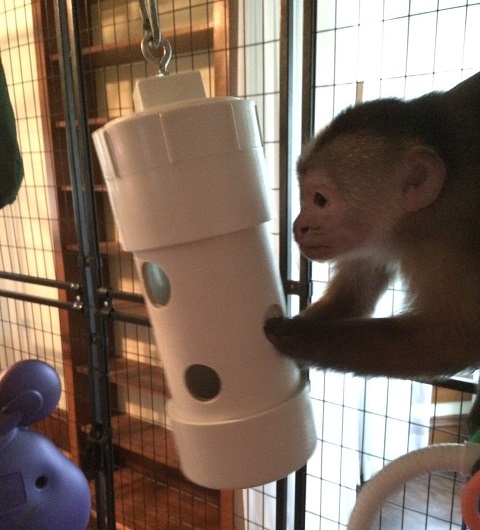
I wanted to talk to you about one of Benji’s favorite enrichment feeders. The goal of this feeder is mainly to prolong feeding time. I build this enrichment feeder over a year ago and as you can tell, it is still in great condition. Since this feeder is made out of PVC, it is not only very durable but it can also be kept clean rather easily. So how does a feeder like did provide any enrichment to your monkey(s)?
Due to the fact that your monkey can’t really see what is in the feeder, he’ll have to dig through the holes to find out what is on the bottom. I typically fill this feeder with seeds, nuts, popcorn, dried fruits and sometimes also mealworms. To prolong feeding time even more, you can also fill it up with things like straw or paper to slow down the retrieval process. You could even drop in an entire banana, just make sure you wash the peel first.
It really isn’t hard to make this primate enrichment feeder, so let’s get started!
Posted in enrichment
Primate Enrichment Cups
January 26, 2014 4:56 pm

One of my favorite topics to talk about is primate enrichment. In the wild primates spent a lot of time hunting for food. As a matter of fact, that is how they mainly keep themselves busy during the day so why not try to mimic this behavior in our homes? The design above is my own creation but it is based on the design of several others that I’ve seen over the years. Some people prefer to use plastic drinking cups but to make this enrichment unit virtual indestructible, I decided to use pipe caps. I had to make some tweaks along the way but am pretty happy with the end-result. I’ve been using these primate enrichment cups with my capuchin for several months now and he loves it. It’s fairly easy to make, so let’s get started!
Posted in enrichment